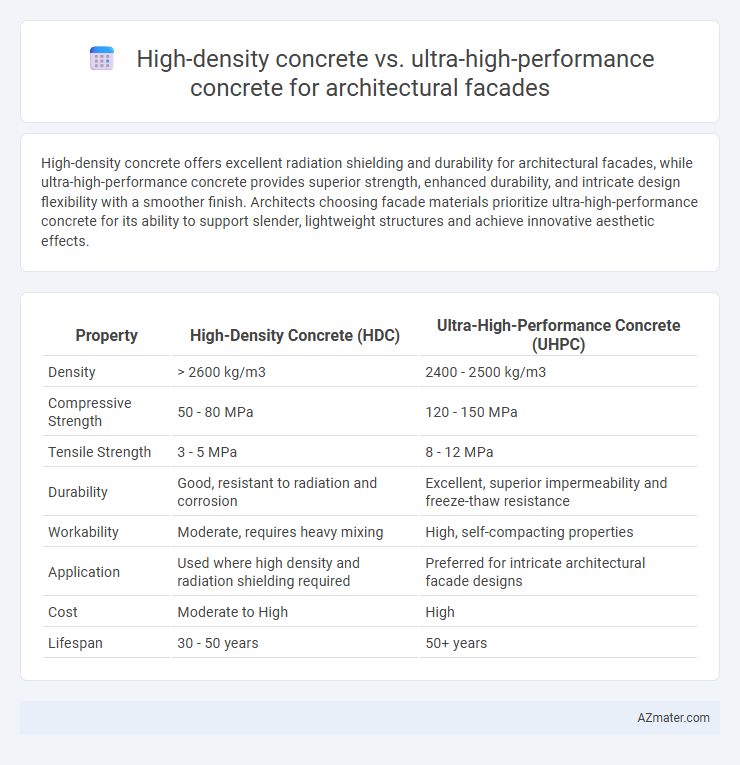High-density concrete offers excellent radiation shielding and durability for architectural facades, while ultra-high-performance concrete provides superior strength, enhanced durability, and intricate design flexibility with a smoother finish. Architects choosing facade materials prioritize ultra-high-performance concrete for its ability to support slender, lightweight structures and achieve innovative aesthetic effects.
Table of Comparison
| Property | High-Density Concrete (HDC) | Ultra-High-Performance Concrete (UHPC) |
|---|---|---|
| Density | > 2600 kg/m3 | 2400 - 2500 kg/m3 |
| Compressive Strength | 50 - 80 MPa | 120 - 150 MPa |
| Tensile Strength | 3 - 5 MPa | 8 - 12 MPa |
| Durability | Good, resistant to radiation and corrosion | Excellent, superior impermeability and freeze-thaw resistance |
| Workability | Moderate, requires heavy mixing | High, self-compacting properties |
| Application | Used where high density and radiation shielding required | Preferred for intricate architectural facade designs |
| Cost | Moderate to High | High |
| Lifespan | 30 - 50 years | 50+ years |
Introduction to High-Density and Ultra-High-Performance Concrete
High-density concrete is characterized by a high mass density typically exceeding 3,800 kg/m3, achieved through the use of heavyweight aggregates such as barite, magnetite, or hematite, providing enhanced radiation shielding and structural weight for architectural facades. Ultra-high-performance concrete (UHPC) is an advanced composite material with compressive strengths above 150 MPa, remarkable durability, and refined rheology, incorporating fine powders, fibers, and optimized particle packing for superior mechanical properties and aesthetic versatility. Both materials offer unique advantages for facade design, with high-density concrete focusing on mass and protection, while UHPC excels in tensile strength, durability, and intricate architectural detailing.
Key Composition Differences
High-density concrete incorporates heavy aggregates such as barite, magnetite, or iron ore, resulting in increased density and radiation shielding properties ideal for specific architectural facades. Ultra-high-performance concrete (UHPC) relies on a mix of fine materials like silica fume, quartz flour, and steel fibers to achieve exceptional strength, durability, and ultra-low permeability. The key composition difference lies in the aggregate type and particle packing, with high-density concrete prioritizing weight and shielding, while UHPC emphasizes microstructure optimization for enhanced mechanical performance.
Mechanical Properties and Strength
High-density concrete offers enhanced mass and excellent radiation shielding with compressive strengths typically ranging from 30 to 60 MPa, making it suitable for structural facades requiring weight and durability. Ultra-high-performance concrete (UHPC) delivers superior mechanical properties with compressive strengths exceeding 150 MPa and exceptional tensile strength due to its fiber reinforcement, allowing for slender, lightweight facade elements with high durability and resistance to environmental stress. UHPC's advanced microstructure provides enhanced toughness and fatigue resistance compared to traditional high-density concrete, making it ideal for intricate architectural applications demanding both strength and aesthetic precision.
Durability and Longevity
High-density concrete offers enhanced durability due to its low porosity and high compressive strength, making it resistant to environmental degradation and suitable for long-lasting architectural facades. Ultra-high-performance concrete (UHPC) surpasses traditional high-density concrete with superior tensile strength, exceptional durability against freeze-thaw cycles, and increased resistance to chemical attacks, ensuring extended longevity in harsh conditions. The superior microstructure of UHPC minimizes permeability and microcracking, providing an optimal solution for sustainable and resilient facade applications.
Aesthetic Versatility in Facade Design
High-density concrete offers exceptional mass and durability, providing a robust visual weight ideal for monumental architectural facades, while ultra-high-performance concrete (UHPC) excels in aesthetic versatility due to its superior tensile strength and fine microstructure, enabling intricate textures and slender profiles. UHPC's ability to incorporate diverse pigments and surface treatments allows architects to achieve dynamic visual effects and complex geometries impossible with traditional high-density concrete. The choice between these materials impacts design flexibility, with UHPC facilitating innovative facade designs that combine performance with high-detail artistic expression.
Structural Performance in Facade Applications
High-density concrete offers enhanced radiation shielding and superior compressive strength, making it suitable for facade applications requiring heavy load-bearing capacity and durability. Ultra-high-performance concrete (UHPC) surpasses traditional concrete with exceptional tensile strength, ductility, and long-term durability, allowing for thinner, lighter facade panels with complex geometries and increased resilience to environmental stressors. Both materials provide distinct structural advantages; high-density concrete excels in mass and protection, while UHPC enables innovative, lightweight facade designs with superior mechanical performance.
Thermal and Acoustic Insulation Capabilities
High-density concrete offers superior thermal insulation due to its increased mass, effectively reducing heat transfer and enhancing energy efficiency in architectural facades. Ultra-high-performance concrete (UHPC) provides exceptional acoustic insulation properties because of its dense matrix and fine microstructure, which minimize sound transmission and vibration. Combining UHPC with insulation materials can optimize both thermal and acoustic performance, making it ideal for modern facade applications requiring stringent environmental comfort standards.
Sustainability and Environmental Impact
High-density concrete offers enhanced durability and radiation shielding, which can reduce lifecycle environmental impact through extended building longevity. Ultra-high-performance concrete (UHPC) provides superior strength with significantly reduced material volume, lowering carbon emissions associated with raw material extraction and transportation. UHPC's dense microstructure improves durability and reduces maintenance needs, further enhancing sustainability in architectural facades.
Cost Considerations and Economic Feasibility
High-density concrete offers cost advantages due to locally available raw materials and simpler production processes but may involve higher transportation and handling expenses because of its weight. Ultra-high-performance concrete (UHPC) features superior durability and reduced maintenance costs, delivering long-term economic benefits despite its higher initial material and manufacturing costs. Choosing between the two depends on project-specific budget constraints, facade performance requirements, and lifecycle cost analysis to ensure optimal economic feasibility.
Best Use Cases for Architectural Facades
High-density concrete (HDC) is ideal for architectural facades requiring enhanced radiation shielding and superior durability in industrial or medical buildings, offering excellent mass and fire resistance. Ultra-high-performance concrete (UHPC) excels in creating thin, lightweight, and highly intricate facade panels with exceptional tensile strength and durability, suitable for modern, minimalist designs and structures demanding complex geometries. UHPC's superior compressive strength and longevity make it the preferred choice for high-performance architectural facades exposed to harsh environmental conditions.

Infographic: High-density concrete vs Ultra-high-performance concrete for Architectural facade
 azmater.com
azmater.com